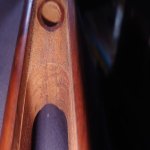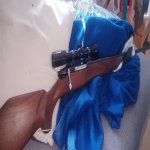What I see in your picture is all hidden under metal - whatever you do to repair will not show once rifle is assembled. I would consider to gouge that out - chisel or saw - really open that up and then re-bed the thing with epoxy - you will want to fix the cause of that crack - could be drying too fast, or could be recoil lug bedding has gone wonky (punky wood), or never was adequate to start with. Your idea of dowels or pins I assume would be inserted from exterior - making them visible? I think that sort of crack could be repaired completely showing nothing once completed?
As far as making it shoot more accurately once the crack is fixed - most will say that a free floated barrel is ideal - but was many quite accurate guns made with "full contact" between barrel channel and barrel - but much harder to do, than to "free-float" and very susceptible to even minor moisture level changes in the wood. About worst is to have some contact at random. I do not know those rifles - is possible they had a "pressure point" in the forearm tip - supposed to be pushing up on the barrel - was common enough to sand those out to see if it would shoot better without. Was also a common enough thing to epoxy bed a pressure point back in, after discovering that the "free-float" did not improve things.
I'd suggest to make your changes one at a time - and have a good idea what is a valid confirmation of change - a single two or three shot group is not it. From your pictures, that appears to be a sporter / hunting rifle - create realistic expectations for that - is not likely that you will make it function as if it was an all-out bench rest or target type rifle - about now you should decide what "good enough" might look like - so that you know when you get there.
To give you some perspective - I try for about 1 MOA for my hunting rifles - most won't do that for 5 shot groups at 100 yards from sandbags - on demand. Most have done so, at least once, or a couple times, but seldom dependably, every time. That said, I have taken many dozens head of game with my rifles. I have never been in a formal target shooting competition, so requirements there might be different. But I think for that type of rifle and scope, a five shot group at 100 yards from sandbags, into a 1" group centre-to-centre, is doing very well. A "hunter" tends to depend on the one, first, cold bore shot - I understand some target disciplines have "warm-up shots" and "sighter shots", and then shoot for group size or the score of multiple shots.
I think the 6000 series was made by Husqvarna in last half of 1960's? - so rifle is circa 55 years old - give or take a few years. Maybe is best to refer to what "good performance" looked like then, compared to now, in 2024.
















































































